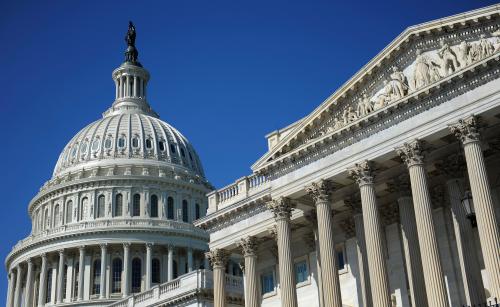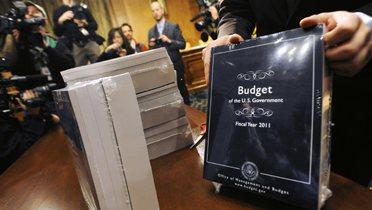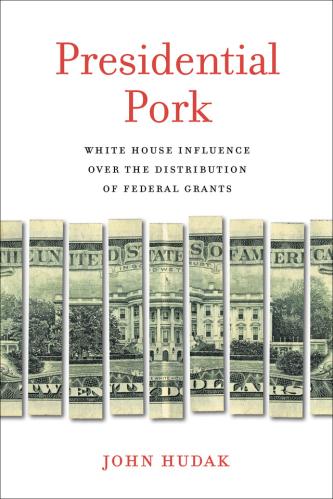Policy Brief #172
Why Institutions Matter
When experts and pundits are asked what the president and Congress should do to promote economic growth, they typically respond with a list of policies, often mixed with stylistic and political suggestions. Few focus on institutional change, which is too easy to conflate with yawn-inducing “governmental reorganization.”
This neglect of institutions is always a mistake, never more than in times of crisis. Throughout American history, profound challenges have summoned bursts of institutional creativity, with enduring effects. The dangerous inadequacies of the Articles of Confederation set the stage for a new Constitution. The Civil War resulted in three amendments that resolved—at least in principle—our founding ambivalence between the people and the states as the source of national authority, between the states and the nation as the locus of citizenship, and between slavery and the equality the Declaration of Independence had proclaimed and promised. Similarly, the Federal Reserve Board, Bretton Woods international economic system, Department of Defense, National Security Council, CIA, Congressional Budget Office and Department of Homeland Security all arose through changes occasioned by great challenges to the nation.
Today’s economic crisis is reflected in three distinct but linked deficits—the fiscal deficit, the savings deficit and the investment deficit. Meeting these challenges and laying the foundation for sustained economic growth will require institutional as well as policy changes.
| RECOMMENDATIONS |
||
| |
Today’s economic crisis is characterized by three distinct but linked deficits—the fiscal deficit, the savings deficit and the investment deficit. Meeting these challenges and laying the foundation for sustained economic growth will require institutional as well as policy changes. The following institution-based recommendations would help the nation meet the current economic crisis and could help prevent future crises of similar destructiveness.
Today’s polarized political system is an obstacle to reform in every area, including the economy. A multi-year collaboration between Brookings and the Hoover Institution produced a series of suggestions. At least two of those suggestions are worth adopting:
|
|
Institutional reform
Promoting fiscal sustainability
Setting the federal budget on a sustainable course is an enormous challenge. If we do nothing, we will add an average of nearly $1 trillion to the national debt every year between now and 2020, raising the debt/ GDP ratio to a level not seen since the early 1950s and sending the annual cost of servicing the debt sky-high. Restoring pay-as-you-go budgeting and putting some teeth in it are a start, but not nearly enough. We need radical changes in rules and procedures.
One option, recently proposed by a bipartisan group that includes three former directors of the Congressional Budget Office, would change the giant entitlement programs: Social Security, Medicare and Medicaid. The new rules would require a review every five years to determine whether projected revenues and outlays are in balance. If not, Congress would be required to restore balance through dedicated revenue increases, benefits cuts or a combination. After a financial crisis in the early 1990s, Sweden introduced a variant of this plan, which has worked reasonably well.A number of Brookings scholars—including Henry Aaron, Gary Burtless, William Gale, Alice Rivlin and Isabel Sawhill—have suggested a Value Added Tax (VAT) as part of a program of fiscal and tax reform. Burtless offers an intriguing proposal that would link a VAT to health care finance. Revenue from the VAT would be dedicated to—and would cover—the federal share of health care programs. If the federal cost rises faster than proceeds from the VAT, Congress would have to either raise the VAT rate or cut back programs to fit the flow of funds. The system would become much more transparent and accountable: because the VAT rate would appear on every purchase, citizens could see for themselves the cost of federal support for health care, and they could tell their representatives what balance they prefer between increased rates and reduced health care funding.
Another option draws on the experience of the Base Realignment and Closure Commission, which enables the military to surmount NIMBY politics and shut down unneeded bases. The basic idea is straightforward: once the independent commission settles on a list of proposed closures, Congress has the option of voting it up or down without amendment. A similar idea undergirds the president’s “fast-track” authority to negotiate proposed trade treaties, which Congress can reject but cannot modify.
Suitably adapted, this concept could help break longstanding fiscal logjams. Here is one way it might work. Independent commissions with members from both political parties could submit proposals in designated areas of fiscal policy. To increase bipartisan appeal, each proposal would require a super-majority of the commission. In the House and Senate, both the majority and the minority would have the opportunity to offer only a single amendment. This strategy of “empowered commissions” changes the incentive structure in Congress, reducing negative logrolling to undermine the prospects of proposals that would otherwise gain majority support.
Empowered commissions represent a broader strategy—using institutional design to insulate certain activities from regular and direct political pressure. For example, the Constitution mandates that federal judges, once confirmed, hold office during “good behavior” and receive salaries that Congress may not reduce during their term of service. (By contrast, many states subject judges to regular election and possible recall.) In another striking example, members of the Board of Governors of the Federal Reserve Board are appointed to 14-year non-renewable terms, limiting the ability of the executive branch to change its membership rapidly and removing governors’ incentives to trim their policy sails in hopes of reappointment. Additionally, action by neither the president nor any other entity in the executive branch is required to implement the Fed’s decisions, and Fed chairmen have been known to take steps that vex the Oval Office.
This strategy is controversial. Officials with populist leanings often argue that fundamental decisions affecting the economy should be made through transparent democratic processes. The counterargument: experience dating back to the founding of the republic suggests that when interest rates and the money supply are set at the whim of transient majorities, economic growth and stability are at risk.
Boosting savings
An adequate supply of capital is a precondition of long-term economic growth, and household saving is an important source of capital. During the 1960s, U.S. households saved 12 percent of their income; as recently as the 1980s, that figure stood at 8 percent. By 2005–2006, the savings rate dipped into negative territory, and today it stands at a meager 3 percent. In recent years, funds from abroad—principally Asia— filled the capital gap. But evidence is accumulating that foreign governments have reached the limit of their appetite (or tolerance) for U.S. debt. To avert a capital shortage and soaring interest rates, which would choke off growth, we must boost private savings as we reduce public deficits.
For a long time, tax incentives for saving have been the tool of choice. But as evidence mounts that these incentives are less effective than hoped, policy experts are turning to alternatives. One rests on a key finding of behavioral economics: default settings have a large impact on individual conduct and collective outcomes. If you require people to opt in to enter a program, such as 401(k) retirement plans, even a modest inconvenience will deter many of them from participating. But if you reverse the procedure— automatically enrolling them unless they affirmatively opt out—you can boost participation.
To achieve an adequate rate of private saving, we may need to go even further. One option is a mandatory retirement savings program to supplement Social Security. Workers would be required to set aside a fixed percentage of earnings and invest them in generic funds—equities, public debt, private debt, real estate, commodities and cash. For those who fail to designate a percentage allocation for each fund, a default program would take effect. (Participants always would have the option of regaining control.) As workers near retirement age, their holdings would be automatically rebalanced in a more conservative direction. One version of this proposal calls for “progressive matching,” in which low-earning individuals receive a subsidy equal to half their payroll contributions; those making more would get a smaller match along a sliding scale, and those at the top would receive no match at all.
This strategy requires careful institutional and programmatic design. To ensure maximum benefits to wage earners, the private sector would be allowed to offer only funds with very low costs and fees. To ensure that the program actually boosts net savings, individuals would be prohibited from withdrawing funds from their accounts prior to retirement; except in emergencies, they would not be allowed to borrow against their accounts; and they would be prohibited from using them as collateral. And a clear line would be drawn to prevent government interference in the private sector: while government-administered automatic default investments would be permitted, government officials could not direct the flow of capital to specific firms.
Improving public investment
The investment deficit has a public face as well. Since the early 19th century, government has financed and helped build major infrastructure projects—roads, bridges, ports and canals, among others, have spurred economic growth and opened new domestic and international markets. Recently, however, public infrastructure investment has fallen well short of national needs, and often has been poorly targeted. Americans travelling and working abroad are noticing that U.S. infrastructure is falling behind not only advanced countries’ but rapidly developing countries’ as well. A study by Emilia Istrate and Robert Puentes of Brookings’s Metropolitan Policy Program, presented in a December 2009 report entitled “Investing for Success,” documents three key shortcomings of federal infrastructure investment: it lacks long-term planning, fails to provide adequately for maintenance costs, and suffers from a flawed project selection process as benefits are not weighed rigorously against costs.
Istrate and Puentes explore several strategies for correcting these deficiencies. One of the most promising is a National Infrastructure Bank (NIB), to require benefit-cost analyses of proposed projects, break down financial barriers between related types of investment (facilitating inter-modal transportation, for example), and improve coordination across jurisdictional lines. The NIB could be funded through a modest initial infusion of federal capital designed to attract private capital. Projects receiving loans from the NIB would have to provide for depreciation and document the sources of funds to repay the face amount of each loan, plus interest. In short, the NIB would be more than a conduit for the flow of federal funds; it would function as a real bank, imposing market discipline on projects and making infrastructure investments attractive to private capital, partly by providing flexible subordinated debt.
Istrate and Puentes identify diverse problems that designers of an NIB would confront. Insulating the selection process from political interference would pose serious difficulties, as would providing federal seed capital without increasing the federal deficit and debt. Requiring the repayment of loans could skew project awards away from projects that cannot easily charge user fees—wastewater and environmental infrastructure projects, for example. Despite these challenges, a properly designed bank could increase the quantity of infrastructure investment while improving its effectiveness, reducing bottlenecks and promoting economic efficiency. The potential benefits for long-term growth would be considerable.
Creating the Political Conditions for Reform
The rise of political polarization in recent decades has made effective action much more difficult for the U.S. government. Polarization has impeded efforts to enact even the progrowth reforms sketched in this paper. A multiyear collaboration between the Brookings and Hoover Institutions—resulting in a two-volume report, Red and Blue Nation?, with Volume One published in 2006 and Volume Two in 2008— has mapped the scope of the phenomenon. This effort has shown that, while political elites are more sharply divided than citizens in general, citizens are more likely now to place themselves at the ends of the ideological spectrum than they were as recently as the 1980s. With a smaller political center to work with, even leaders committed to bipartisan compromise have been stymied. The fate of President Bush’s 2005 Social Security proposal illustrates the difficulty of addressing tough issues in these circumstances.
It might seem that the only cure for polarization is a shift of public sentiment back toward moderation. The Brookings-Hoover project found, however, that changes in institutional design could reduce polarization and might, over time, lower the partisan temperature. Here are two ideas, culled from a much longer list.
Congressional redistricting
While population flows account for much of the growth in safe seats dominated by strong partisans, recent studies indicate that gerrymanders account for 10 to 36 percent of the reduction in competitive congressional districts since 1982. This is not a trivial effect.
Few Western democracies draw up their parliamentary districts in so patently politicized a fashion as do U.S. state legislatures. Parliamentary electoral commissions, operating independently and charged with making reasonably objective determinations, are the preferred model abroad.
Given the Supreme Court’s reluctance to enter the thicket of redistricting controversies, any changes will be up to state governments. In recent years, voter initiatives and referenda in four states—Washington, Idaho, Alaska and Arizona—have established nonpartisan or bipartisan redistricting commissions. These commissions struggle with a complicated riddle: how to enhance competitiveness while respecting other parameters, such as geographic compactness, jurisdictional boundaries, and the desire to consolidate “communities of interest.” Iowa’s approach, where a nonpartisan legislative staff has the last word, is often cited as a model but may be hard to export to states with more demographic diversity and complex political cultures. Arizona has managed to fashion some workable, empirically based standards that are yielding more heterogeneous districts and more competitive elections.
Incentives to participate
Another depolarizing reform would promote the participation of less ideologically committed voters in the electoral process. Some observers do not view the asymmetric power of passionate partisans in U.S. elections as a cause for concern: Why shouldn’t political decisions be made by the citizens who care most about them? Aren’t those who care also better informed? And isn’t their intensive involvement an indication that the outcome of the election affects their interests more than it affects the interests of the non-voters? While this argument has surface plausibility, it is not compelling. Although passionate partisanship infuses the system with energy, it erects road-blocks to problem-solving. Many committed partisans prefer gridlock to compromise, and gridlock is no formula for effective governance.
To broaden the political participation of less partisan citizens, who tend to be more weakly connected to the political system, several major democracies have made voting mandatory. Australia, for one, has compulsory voting; it sets small fines for non-voting that escalate for recidivism, with remarkable results. The turnout rate in Australia tops 95 percent, and citizens regard voting as a civic obligation. Near-universal voting raises the possibility that a bulge of casual voters, with little understanding of the issues and candidates, can muddy the waters by voting on non-substantive criteria, such as the order in which candidates’ names appear on the ballot. The inevitable presence of some such “donkey voters,” as they are called in Australia, does not appear to have badly marred the democratic process in that country.
Indeed, the civic benefits of higher turnouts appear to outweigh the “donkey” effect. Candidates for the Australian Parliament have gained an added incentive to appeal broadly beyond their partisan bases. One wonders whether members of Congress here in the United States, if subjected to wider suffrage, might also spend less time transfixed by symbolic issues that are primarily objects of partisan fascination, and more time coming to terms with the nation’s larger needs. At least campaigns continually tossing red meat to the party faithful might become a little less pervasive.
The United States is not Australia, of course. Although both are federal systems, the U.S. Constitution confers on state governments much more extensive control over voting procedures. While it might not be flatly unconstitutional to mandate voting nationwide, it would surely chafe with American custom and provoke opposition in many states. Federalism American-style also has some unique advantages, including its tradition of using states as “laboratories of democracy” that test reform proposals before they are elevated to consideration at the national level. If a few states experiment with compulsory voting and demonstrate its democracy- enriching potential, they might, in this way, smooth the path to national consideration.
Conclusion
In challenging times, political leaders undertake institutional reform, not because they want to, but because they must. Our own era—a period of profound economic crisis—is no exception. Even in circumstances of deep political polarization, both political parties have accepted the need to restructure our system of financial regulation.
As well, recognition is growing that we face three key challenges—a fiscal deficit, a savings deficit and an investment deficit—that have eluded control by existing institutions and, unless checked, will impede long-term economic growth. The question is whether we will be able to adopt the needed changes in an atmosphere of reflection and deliberation, or whether we will delay until a worse crisis compels us to act.









